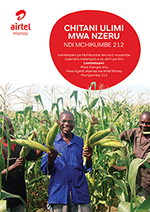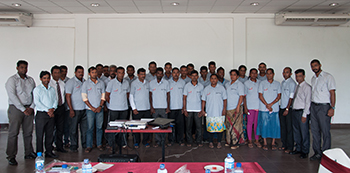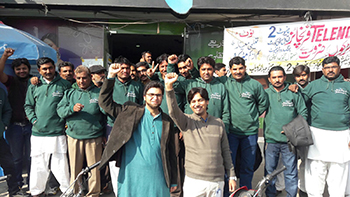Looking back at everything that happened in 2015, it’s hard to overestimate the velocity in mobile agriculture space that we collectively achieved as an industry. We are finally seeing that mobile operators are taking a leading role in creating value for rural segment while donors and social impact investors are aiming for user-centricity of mobile solutions for social impact. The next big challenge for the industry will be around unlocking the pathway to financial inclusion for rural families, while building on the existing knowledge of the rural users and their transactional and information needs.
In 2015 mAgri team at GSMA have been focusing on firstly, supporting six of our current grantees to design and launch the mobile agriculture services and secondly, building the knowledge base for the wider ecosystem by sharing what we have learned along the way. It is very exciting to see four of the services we have worked with being fully operational (Airtel Malawi, Vodafone Ghana, Dialog Sri-Lanka and Grameenphone Bangladesh) and two more running in pilot mode generating first sets of valuable usage data and user insights (Telenor Pakistan and Ooredoo Myanmar). GSMA has worked collaboratively with frog design during the whole of last year to support the customer research and service design across six markets. You can enjoy the summary of key research and design tools in our signature publication The mAgri Design Toolkit that aims to help all practitioners out there to increase the relevance of their solutions to the end users while building capacity of their internal teams to manage research and user-centric product development.
 For all the skeptics out there still contemplating on the value of mobile for rural smallholder families we have prepared an impact evaluation of Agri VAS with proof points on adoption of new agriculture practices. We have seen that even basic SMS-based solutions increase farmers willingness to invest in new farming methods and new crops by 30%. Check-out the full report here.
For all the skeptics out there still contemplating on the value of mobile for rural smallholder families we have prepared an impact evaluation of Agri VAS with proof points on adoption of new agriculture practices. We have seen that even basic SMS-based solutions increase farmers willingness to invest in new farming methods and new crops by 30%. Check-out the full report here.
Last year has also seen a number of break-through launches and spin-offs that mark a new chapter in mobile operators’ involvement in mobile agriculture space. Vodafone has always set a benchmark when it comes to identifying strategic opportunities or pioneering new solutions across end-user services, B2B platforms and mobile financial services for agricultural players. Moving even further in 2015 Vodafone has published a fantastic overview of opportunities that agriculture industry in India represents for mobile technology players. This report advocates not only for the strategic involvement of mobile operators, but also for the first time puts a number on the opportunity for digitisation of payments in agriculture – rounding up to USD 28 million in annual savings for agribusinesses from reduced cash handling costs.  Leading by example, in 2015 Vodafone has scaled their Vodafone Farmer Club success story from Turkey to a number of other international markets, namely: Ghana (with the support of GSMA), Egypt, India, Kenya, Tanzania and very soon – New Zealand. Vodafone has also announced its early efforts to develop an online platform for Australian farmers. At the same time Vodafone’s Connected Farmer platform that provides all-in-one supply chain solution to agricultural businesses that source from small-holders has been proven as a business success and is now scaling outside of original countries (Kenya, Tanzania, Mozambique) to South Africa and potentially many others.
Leading by example, in 2015 Vodafone has scaled their Vodafone Farmer Club success story from Turkey to a number of other international markets, namely: Ghana (with the support of GSMA), Egypt, India, Kenya, Tanzania and very soon – New Zealand. Vodafone has also announced its early efforts to develop an online platform for Australian farmers. At the same time Vodafone’s Connected Farmer platform that provides all-in-one supply chain solution to agricultural businesses that source from small-holders has been proven as a business success and is now scaling outside of original countries (Kenya, Tanzania, Mozambique) to South Africa and potentially many others.
The year 2015 was also a turning point for innovation projects within Telenor Pakistan as they separated a couple of strategic initiatives from the core business into an adjacent innovation unit, among them mAgriculture, IOT and mAdvertisement. With more agile organizational structure, tailored performance metrics and design approach to product development, they are likely to prove that mobile operators can lead the game in the next generation of digital services while co-creating with vendors and solution partners.
 Moving ahead into 2016 we anticipate a lot of interesting and ground-breaking insights to come from all the players out there that are joining their efforts in developing digital financial services for small-holders. As much as we are looking forward to a much needed publication of research insights, such as financial diaries study by CGAP in early 2016, we expect that the next wave of innovation would come from user-centered and agile commercial players that develop holistic value chain solutions and solutions for rural families and start creating digital records and credit history for those who are currently not being served by traditional financial institutions. One example is pioneering social enterprise Virtual City which through its G-Soko platform has taken the leap in digitizing value chain payments enabling farmers integrated in agricultural value chains to print out a history of payments for their produce and walk into a bank requesting access to financial services. Another extraordinary example is a release of credit history on 80’000 households as a public good by M-Kopa in Kenya.
Moving ahead into 2016 we anticipate a lot of interesting and ground-breaking insights to come from all the players out there that are joining their efforts in developing digital financial services for small-holders. As much as we are looking forward to a much needed publication of research insights, such as financial diaries study by CGAP in early 2016, we expect that the next wave of innovation would come from user-centered and agile commercial players that develop holistic value chain solutions and solutions for rural families and start creating digital records and credit history for those who are currently not being served by traditional financial institutions. One example is pioneering social enterprise Virtual City which through its G-Soko platform has taken the leap in digitizing value chain payments enabling farmers integrated in agricultural value chains to print out a history of payments for their produce and walk into a bank requesting access to financial services. Another extraordinary example is a release of credit history on 80’000 households as a public good by M-Kopa in Kenya.
One key takeaway from the Global Partnership for Financial Inclusion (GPFI), a roundtable on innovation in agricultural finance we attended this fall, was that no single player in the ecosystem – operators, banks, agribusinesses – will be able to offer all answers to the financial needs of smallholder farmers. If we want to create viable, scalable and desirable digital financial services for this segment, partnerships will be fundamental. This is where we see the role of Mobile Operators to actively engage with the forward thinking solution providers and be ready to form strategic partnerships in order to provide valuable solutions for the rural.

